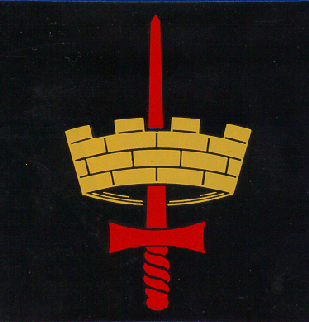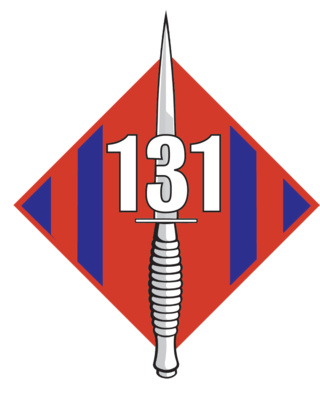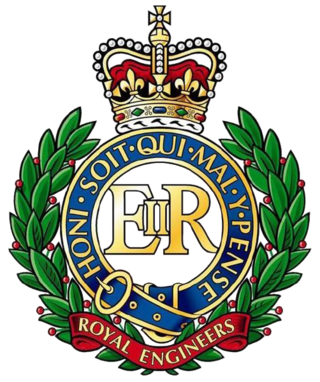
Royal Air Force Wyton or more simply RAF Wyton is a Royal Air Force station near St Ives, Cambridgeshire, England. The airfield is decommissioned and the station is now under the command of UK Strategic Command.

The Corps of Royal New Zealand Engineers is the administrative corps of the New Zealand Army responsible for military engineering. The role of the Engineers is to assist in maintaining friendly forces' mobility, deny freedom of movement to the enemy, and provide general engineering support. The corps has been involved in numerous conflicts over the course of its history including World War I, World War II, the Korean War, the Vietnam War and the war in Afghanistan. The corps consists of a single regiment, 2nd Engineer Regiment, primarily based at Linton Military Camp near Palmerston North.

London District (LONDIST) is the name given by the British Army to the area of operations encompassing the Greater London area. It was established in 1870 as Home District.

The Special Operations Engineer Regiment (SOER) is a specialised unit of the Australian Army. The regiment forms part of the Special Operations Command. The unit was formed in 2002 as the Incident Response Regiment (IRR), they are deployed to respond to chemical, biological, radiological, nuclear or explosive incidents. The regiment was transferred into the newly raised Special Operations Command in 2003. In 2010 and 2011, its role changed to supporting the army's special forces units, and it was renamed accordingly.
This is the Operation Herrick ground order of battle, which lists any British ground forces that have taken part in the duration of Operation Herrick between 2002 and 2014.

131 Commando Squadron Royal Engineers is an Army Reserve unit and part of 24 Commando Regiment Royal Engineers. It provides engineering support to 3 Commando Brigade Royal Marines and is the largest Army Reserve Commando unit. The squadron has deployed worldwide to provide combat engineer support to 3 Cdo Bde RM, often deploying in small sub-units. 131 was first raised in 1947 as an airborne engineer regiment, and reached a strength of over 1,000 trained parachute engineers by the early 1960s. Between 1 April 1978 and 1 October 2015, the unit was an independent Commando squadron under operational command of HQ 3 Cdo Bde RM. On 2 October 2015, it formally became the third squadron of 24 Commando Engineer Regiment.
The 2nd Combat Engineer Regiment (2 CER) is an Australian Army combat engineer regiment located at Gallipoli Barracks in Brisbane, Queensland. It is part of the Australian 7th Brigade, attached to Forces Command (Australia).
5th Engineer Regiment is a Reserve unit of the Royal Australian Engineers. Originally raised as the "5th Combat Engineer Regiment" in 1995 from the 4th Field Engineer Regiment, it is based in Holsworthy, Sydney, with one of its sub-units based at the multi-user depot HMAS Harman, in Canberra and another at Orchard Hills and Dundas. Some of the unit's subunits draw lineage from the 4th and 5th Field Companies, which were raised for service during World War I.
75 Engineer Regiment is a Royal Engineers regiment, part of the British Army's Army Reserve.
The 1st Combat Engineer Regiment is a combat engineer regiment of the Australian Army. Based in the Northern Territory and attached to 1st Brigade, it is a Regular Army unit of the Royal Australian Engineers and is tasked with providing mobility and counter mobility support.

The 15 Field Squadron is a Field Squadron of the Royal Engineers a part of the British Army based in Wimbish.

The 21st Construction Regiment was a construction engineer regiment of the Australian Army Reserve. Part of the 5th Brigade, the regiment was formed in 1950 and was based in New South Wales where it provided support to the 2nd Division. The regiment has contributed personnel to a number of operations including the Regional Assistance Mission to the Solomon Islands, Operation Slipper and Operation Astute. It also regularly supported the Army Aboriginal Community Assistance Program and provided assistance to the Australian community in times of natural disaster. The regiment was disbanded in 2013.
The Defence Intelligence Fusion Centre (DIFC) is based at RAF Wyton in Cambridgeshire. Largely created from the staff of the National Imagery Exploitation Centre and then known for several years as the Defence Geospatial Intelligence Fusion Centre, it can trace its history back to clandestine reconnaissance operations at the beginning of the Second World War by Sydney Cotton on behalf of MI6 and then MI4, and the formation of the Allied Central Interpretation Unit at RAF Medmenham.
The 11th Engineer Regiment(11ER) is an Australian Army Reserve engineer regiment trained for sapper/combat engineer and construction engineer operations. While 11 ER was formed on 1 January 2014 as a result of recent Australian Army modernisation efforts, 11 ER's lineage is traced back to early Queensland volunteer engineer units as early as 1879. In 1916, 11th Field Company was formed and during World War I, this unit was renowned for action during the Battle of the Somme and the Hindenburg Line. During World War II, it fought the Japanese during the Kokoda Track campaign and on Bougainville Island. The Regiment's Headquarters is located at Gallipoli Barracks in Brisbane, Queensland with subunits located across Queensland. 11ER is part of 11th Brigade, attached to Forces Command.

The School of Engineers is part of the South African Army Engineer Formation, which provides combat engineering corps training and teaching to military officers and personnel as well as other Military Schools throughout the South African National Defence Force. They are currently the only Military School in Southern Africa to formally present IEDD.
42 Engineer Regiment (Geographic) is a Royal Engineers regiment of the British Army. The regiment, formed originally in 1947, provides field deployable geographic services, including geodetic survey, terrain analysis, information management and dissemination and geospatial intelligence (GEOINT).
This is a list of units of the British Army's Royal Engineers.
The 72nd Engineer Regiment was a territorial regiment of the Royal Engineers, British Army, for three periods between 1967 and 2014. The regiment was later reduced to squadron size and renamed as 103 Field Squadron within 71 Engineer Regiment.

The GurkhaAllied Rapid Reaction Corps Support Battalion, or simply the GurkhaARRC Support Battalion is a combat support unit of the British Army, and one of only three units permanently assigned to NATO. For administrative purposes, the Gurkha ARRC Support Battalion falls under the oversight of the Royal Logistic Corps, though employs members from many other cap badges.

299 Parachute Squadron, Royal Engineers is a specialist field engineer squadron of the British Army's Corps of Royal Engineers and the only reserve parachute unit of the corps. Formed in 1947 as an airborne field squadron, 299 Para Sqn would see many reorganisations and new roles, until 2006 when it took on the parachute role it maintains today. As of 2021, it is the only reserve parachute-trained squadron of the Royal Engineers.










